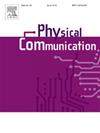基于深度强化学习的全双工通信模拟自干扰消除
IF 2
4区 计算机科学
Q3 ENGINEERING, ELECTRICAL & ELECTRONIC
引用次数: 0
摘要
全双工(FD)通信系统有望在无线通信中得到广泛应用,但由于自干扰(SI),其性能受到严重限制。传统的模拟自干扰消除(ASIC)方法通常不考虑SI通道的延迟估计,因此需要大量的抽头来捕获通道细节。为了在资源或空间有限的情况下有效地消除SI,我们提出了两种基于深度强化学习(DRL)的新型ASIC方案,即Multi-Deep Q Network (Multi-DQN)方案和DQN-Deep Deterministic Policy Gradient (DQN-DDPG)方案。具体来说,对于Multi-DQN方案,我们使用多个DQN单元来离散地估计SI通道的延迟和衰减,这可以有效地减少ASIC所需的抽头数量。为了克服离散化的损失,DQN-DDPG方案分别利用DQN和DDPG单元来估计SI通道的延迟和连续衰减。仿真结果表明,两种方案均能在较少抽头的情况下获得与多抽头方法相似的性能。此外,两种方案的有效性在各种场景中得到验证,包括系统配置、超参数和信道变化。本文章由计算机程序翻译,如有差异,请以英文原文为准。
Analog self-interference cancellation for full-duplex communication based on deep reinforcement learning
Full-duplex (FD) communication systems are expected to be extensively used in wireless communications, however, their performance is severely limited due to the self-interference (SI). Traditional analog self-interference cancellation (ASIC) methods generally do not consider estimating the delay of the SI channel, thereby requiring a large number of taps to capture channel details. In order to effectively eliminate SI in situations with limited resources or space, we propose two novel ASIC schemes based on deep reinforcement learning (DRL), named Multi-Deep Q Network (Multi-DQN) scheme and DQN-Deep Deterministic Policy Gradient (DQN-DDPG) scheme. Specifically, for the Multi-DQN scheme, we use multiple DQN units to estimate the delay and attenuation of the SI channel discretely, which can effectively reduce the number of taps required for ASIC. To overcome the loss of discretization, the DQN-DDPG scheme utilizes DQN and DDPG units to estimate the delay and continuous attenuation of the SI channel, respectively. Simulation results indicate that both proposed schemes achieve a similar performance to the multi-tap methods with fewer taps. Additionally, the effectiveness of both schemes is verified across various scenarios, encompassing system configurations, hyperparameters, and channel changes.
求助全文
通过发布文献求助,成功后即可免费获取论文全文。
去求助
来源期刊

Physical Communication
ENGINEERING, ELECTRICAL & ELECTRONICTELECO-TELECOMMUNICATIONS
CiteScore
5.00
自引率
9.10%
发文量
212
审稿时长
55 days
期刊介绍:
PHYCOM: Physical Communication is an international and archival journal providing complete coverage of all topics of interest to those involved in all aspects of physical layer communications. Theoretical research contributions presenting new techniques, concepts or analyses, applied contributions reporting on experiences and experiments, and tutorials are published.
Topics of interest include but are not limited to:
Physical layer issues of Wireless Local Area Networks, WiMAX, Wireless Mesh Networks, Sensor and Ad Hoc Networks, PCS Systems; Radio access protocols and algorithms for the physical layer; Spread Spectrum Communications; Channel Modeling; Detection and Estimation; Modulation and Coding; Multiplexing and Carrier Techniques; Broadband Wireless Communications; Wireless Personal Communications; Multi-user Detection; Signal Separation and Interference rejection: Multimedia Communications over Wireless; DSP Applications to Wireless Systems; Experimental and Prototype Results; Multiple Access Techniques; Space-time Processing; Synchronization Techniques; Error Control Techniques; Cryptography; Software Radios; Tracking; Resource Allocation and Inference Management; Multi-rate and Multi-carrier Communications; Cross layer Design and Optimization; Propagation and Channel Characterization; OFDM Systems; MIMO Systems; Ultra-Wideband Communications; Cognitive Radio System Architectures; Platforms and Hardware Implementations for the Support of Cognitive, Radio Systems; Cognitive Radio Resource Management and Dynamic Spectrum Sharing.
 求助内容:
求助内容: 应助结果提醒方式:
应助结果提醒方式:


